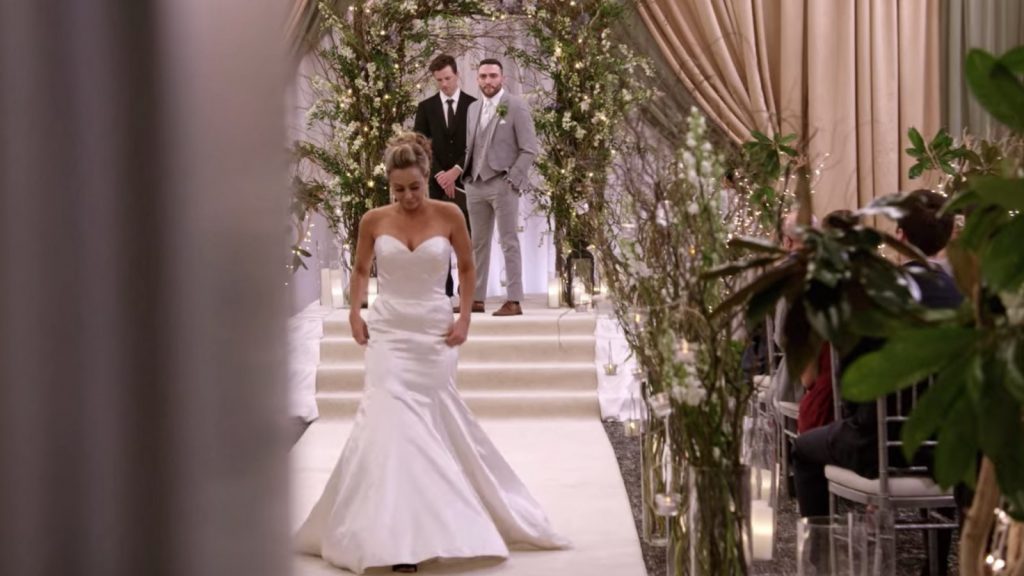By Holly McElroy
Netflix’s new dating show Love is Blind presents itself as a social experiment, where single women and men date in booths where they cannot see each other, before deciding whether or not they want to get engaged. If they do decide to get married, so begins a whirlwind of a group honeymoon in Mexico, moving into apartments and meeting the family until finally walking down the alter a mere 30 days after. You know, just the usual boy meets girl love story.
Appropriately realised near Valentine’s Day of 2020, the show seems to pride itself as a return to a simpler style of dating, devoid of the recent tropes of dating apps and trying to a return to the heart of what makes a successful relationship. In the case of Love is Blind, this is a focus on the internal qualities and meaningful communication as opposed to instant physical attraction. And yet in this over-dramatic and clinical ÔÇÿreality show’, despite the quirks of having contestants not see each other before they propose, it readily returns to the inevitable pitfalls of dating as a millennial. In fact, it intensifies them.
Despite the increasing visibility of LGBTQ+ identities and narratives in the mainstream media, reality dating shows have been slow to represent these marginalised groups in their own programmes. Look at the UK’s Love Island which, despite inclusion of bisexual participants like Sophie Graydon and Katie Salmon is Season 2, and Megan Barton-Hanson in Season 4, continues to use a format which favours and rewards heterosexual couplings.
Where Love Island views a successful relationship as a  bonus of the £50,000 cash prize and a massive social media following, Love is Blind offers a different but equally toxic relationship aspirations. Throughout the show, the audiences are spoon-fed this idealist and dishonest heterosexual paradigm of love that is rose petals, chocolate-covered strawberries and grand displays of affection. And those who cannot conform to this model of heteronormative love are effectively punished for it and left on the margins. Most notably seen through Carlton Morton, the only non-heterosexual contestant who recognises himself as bisexual and is for the most part treated as the sad villain of the show when he does not provide Diamond Jack her model of the fairy-tale ending for failing to disclose his sexuality sooner.
Another example is when Lauren Speed does not want to give up her apartment to move in with Cameron Hamilton, she is periodically pushed into a view that marriage necessitates cohabitation. ┬áThis follows the narrative that marriage an act that requires women to give up their possessions and accept the passive role of being cared for by a man ÔÇô who would traditionally be the breadwinner of the relationship.┬áWhile the couple remain happily married to this day, this scene leaves a concerned and uncomfortable feeling for the viewer. It seems that through this relationship, one party is sacrificing far more than the other and there is a lack of will from both Cameron and the show to recognise or critique this imbalance.
The most problematic and uncomfortable pairing is Mark Cuevas and Jessica Batten, whose entire relationship is based on a so man desperate to find love and a woman who cannot decide between two men in the pods, is then rejected by one and begrudgingly returns to the other. The truth is universally apparent, Jessica is not into Mark, but instead of admitting this, she proceeds to gaslight him. Jessica drinks and extortionate amount of wine throughout their engagement in what seems an attempt to find Mark attractive in her inebriation. When that does not work, she changes her tactics, becoming somewhat cold and distant in the hopes that he will do the right thing and break up with her before she has to. This behaviour is of unfulfillment and causes Jessica to use their age gap as a source of her lack of feelings, exerting blame on Mark for something entirely out of his control. Things further come to ahead when Jessica comments on the attractiveness of other contestants as a way of pushing Mark away and making her lack of attraction towards him clear without having to discuss or communicate it in an upfront nature. This portrayal of gas lighting is one experienced by many millennial daters who often lazily and selfishly project feelings of unfulfillment onto their partners in an attempt to seem blameless to the outside world.

Jessica leaves Mark at the alter
Photo: Netflix
Fundamentally what Love is Blind teaches is us is that millennials think marriage is a joke. That’s why shows like this are so popular because they confirm the belief that marriage has in fact always been a somewhat inherently ridiculous institution. The core concepts of the show of falling in love without seeing a person and getting married within a month are far-fetched and highly uninspiring. What is romantic about a forced deadline for commitment? This trivial premise is a microcosm for how intrinsically inept marriage is in the first place. Given that fewer millennials are deciding to get married at all (only 2/5 millennials were married as of 2015) it appears Love is Blind offers us some kind of ironic catharsis, as if seeing others suffer at the hand of their own delusions about love reconfirms the sense in our own.
And so, does Love is Blind offer a fresh take on love in the time of reality dating shows? Not really. In fact, it amateurishly struggles and fails to prove its own message and in doing so showcases the worst of modern dating trends. Whether it be gas lighting or the unwavering focus on heteronormative love and patriarchal philosophies, Love is Blind suggests these still linger even in 2020. What the show lacks in inspirational success stories of modern relationships, it tries to make up for by providing dramatic, bizarre and hilariously unrealistic scenarios that will guarantee large viewership for years to come.


